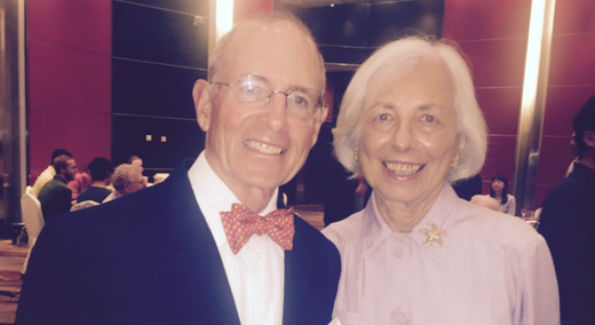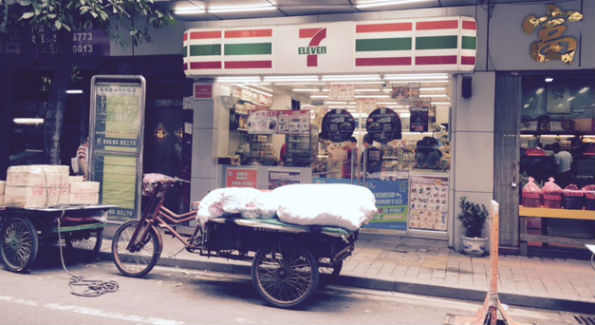One traveler recounts an unforgettable trip to China with the Choral Arts Society.
By Kandie Stroud
May 21
“In a world still suffering from wars and military conflicts, music, as a language without boundaries, undoubtedly plays an important role in purifying the soul, as well as promoting world peace, communication and understanding among people of various races and religions.” So said Maestro Zhang Gouyong, music director of the Qingdao Symphony, words which inspired and uplifted 88 members of The Choral Arts Society of Washington as we departed on a whirlwind two week tour from May 23-June 6 to perform Carl Orff’s brassy, lusty Carmina Burana with Zhang and his dynamic young orchestra to thunderous applause and explosive bravis from warm, enthusiastic Chinese audiences in the stunning modern concert halls of Qingdao, Bejing, Shanghai, Guangzou and Hong Kong. Sponsored by the Chinese Ministry of Culture as part of the “Meet in Beijing” Arts Festival, the tour, six years in the making, and labeled “Two Countries, One Stage,” offered our American symphonic chorus the opportunity not only to raise Chinese spirits with this sassy, triple fortissimo contemporary work but also to witness the power of the new China and its aggressive modernity and growth. Conversely, the Chinese seemed dazzled by Western power and culture which they have not only incorporated but magnified mightily from their spectacular five- star James Bond-ish Grand Hyatt hotels to their futuristic, towering skyrises, gleaming shopping malls and majestic concert venues.

Former IRS Commissioner Charles Rossotti and wife Barbara fly to Qingdao for first concert (Photo by Kandie Stroud)
May 22
Some forty chorus members and guests arrived two days ahead of the rest of the chorus on an extension tour to Xi’an, the ancient capitol of China where the Emperors and Empress of the Zhou, Qin, Han, Sui and Tang dynasties ruled for thousands of years before the capitol moved to Beijing. Xi’an today bursts with business, towering office buildings, and boasts the number one tourist attraction in China—the Terra Cotta Warriors. Some six thousand lifelike figures, each with a different visage and once brightly painted, were crafted two thousand years ago to guard the Emperor Qin Shi Huang in his afterlife. Qin began preparing his tomb thirty years before his demise, enlisting some 750,000 workers to create his clay army. Unfortunately, shortly after completion, the soldiers were busted into smithereens and burned by revolutionary marauders. For two thousand years billions of broken bits lay buried beneath charred rubble until farmers digging a well accidently discovered them in 1944. But never say the Chinese can’t put Humpty Dumpty back together again. Already, more than 1600 of the soldiers, horses and chariots have been painstakingly reassembled by Chinese artisans as well as architects and volunteers from around the globe and now reside in a vast structure the size of Dulles Airport. This phenomenon, dubbed by some the eighth wonder of the world, attracts over a million visitors a year. Move over Taj Mahal.
May 23 Xi’an
The contrasts of modern and ancient life abound in Xi’an. In the Metro trendy young Chinese dash for trains in floaty skirts and stretch tops. Clarins and Folli Follie hawk their wares in an ancient square along with a chrome and glass Starbucks facing the massive Bell Tower built in 1384 by Emperor Zhu Yuanzhang to dominate the landscape and provide early warning of approaching rivals. Now at the tower, whose bells chimed the local time back in the fourteenth century, Chinese families ask to take photos with us on Iphones.
Our first night in Xi’an we are treated to a reenactment of musical entertainment provided to the royals during the Golden Age of the Tang emperors.
Qingdao
We fly to the seaside city of Qingdao, joining the rest of the chorus who arrive from DC along with our music director, Scott Tucker and his Taiwanese wife, Julie, for our first performance in the Quingdao Grand Theater. Post a passionately received performance, in a vast red room, Maestro Zhang and the orchestra provides an enormous 18 course welcome banquet celebrating Sino-US cultural cooperation, the 10th anniversary of the orchestra and the 50th anniversary of the Choral Arts Society. We are toasted with the words, “Confucius once said, “it is a delight to have friends come from afar.”
May 29 Beijing
Leaving behind both the largest beach in Asia, where many of us had jogged and waded in the Yellow Sea, and sampled the mild, delicious beer at the Tsingtao brewery built by Germans at the turn of the century, we board the spotless, shiny, silent, Bullet Train to Beijing for our second performance in Paul Andreu’s stunning concert venue known as “The Egg.” The train ride is so smooth that even at almost 195 mph, you can walk the aisles without holding on. Beijing’s population of 21.5 million is now struggling with 5.7 million cars, most of which we encounter the following day on a 7 hour round trip bus ride to the Mutiyanu section of the Great Wall of China—one of the seven wonders of the world. This stone buffer, which once stretched, according to some archeologists 14,000 miles and begun in the 7th Century BC, was built not just to protect the Silk Route but to keep out horses. Potential enemies like the dreaded Mongolians. Mongolian warriors could have climbed the wall with ladders, but their bodacious cavalry, the source of their military might–could not. Today’s Great Wall is digital not stone. Google is jammed and getting on line, even at Five Star hotels, is extremely slow if not impossible. Traffic jams cause us to miss our warm up, resulting in one or two ragged movements. Fortunately, the audience hears no glitches and showers us with flowers, shouts and sustained applause.
May 30
You cannot help but notice the smartly dressed Beijingese, often in black and white mini skirts or dresses and the newest trend—rhinestone or silver shoes. The Chinese have always set trends. Marco Polo got the recipe for pasta from Mongolians back in 1275. They also taught him how to bury yogurt underground in winter ice and gelato was born. We tour the vast Forbidden City, built for the imperial family, between 1406 and 1420 where our guide, Jeff, informs us that concubines were the solution to the imperial lack of exercise. Each night a different one was brought to the Emperor — naked and sealed inside a bag so as to prevent weapons from being smuggled into the royal bedroom. These royal exercise providers who were selected between the ages of 5-12 and retired at 25, lived royally in a heightened state of jealousy and hatred for each other. The perils of palace life.
June 1
The chorus boards the Bullet Train for a five hour trip to Shanghai. En route we learn that the average annual wage of a young Chinese man or woman working for a big company in a major city today is approximately $80,000 whereas a supermarket employees would earn only about $1,000/month. Hardly enough to pay for a car (License plates alone cost about $17,000) or a one or two bedroom apartment with a sticker price of about $800,000. Until the middle class grows additional earning power, thousands of high rise apartments built to house them remain empty. Most Chinese live in one room flats about 440 square feet in size with in-laws who attend to the children. Laundry hangs outside the windows. Older Chinese believe the sun is healthier than dryers.
If Beijing was all about government, Shanghai is all about finance. The Bund, China’s Wall Street, features wall to wall foreign investment banks, towering office buildings which come alive at night with brightly colored lights that illuminate their spectacular facades. Joyful young Chinese promenade along the Bund Riverwalk snapping thousands of Iphone photos.
We visit a Shanghai park where retired people exercise daily. An improv saxophone band plays while an elderly woman dances, others shake maracas, others dance spinning paper dragons around their bodies. Impromptu choruses sing Jingle Bells or Auld Lang Syne as we happily chime in to their delight.
The day ends in the vast glass Shanghai Oriental Arts Center, throbbing with the cheers of an audience enraptured not just by the chorus’s exceptionally lively and passionate Carmina performance, but also by the soaring voice of our stunningly beautiful Chinese soprano, Song Yuanming, who reaches her high E in the Dulcissima movement,with ease and grace. She could shatter glass.
June 2
After a 2 1/2 hour delay due to storms we fly to Guangzhou, the third largest city in China, home of the lychee and the world’s tallest tv tower. The orchestra is not as lucky. After 12 hours in the airport, their flight is cancelled and they arrive the next day only three hours before the downbeat in the Guangzhou Opera House. Several instruments fail to arrive and are borrowed at the last moment. The loaner tuba delivers a ferocious blat not intended by its accomplished player. Still, these incredible musicians, as always, deliver a reliable tour de force.
We visit Old Canton’s markets. Outdoor stalls and narrow alleys where old and new combine as storekeepers working on laptops hawk two thousand year old Chinese medicine–scorpions to prevent stroke, starfish for the lungs, deer antlers for male potency. Next door to these ancient remedies a modern hospital offers both eastern and western medicine while a rickshaw parks outside a 7/11.
June 4
The chorus travels to Hong Kong, passing through magnetomers, bomb dogs, MERS masks, retina scanners and hundreds of ceiling cameras at Immigration which make TSA look tame. In the evening we ferry from Kowloon to Hong Kong island and ascend Victoria Peak by tram for a breathtaking view somewhat reminiscent of seeing NYC from New Jersey. Think Manhattan with mountains.
Our final concert June 5 at Hong Kong’s Sha Tin Town Hall is our finest performance, honed over 14 days. Chorus and orchestra now form a single well-oiled and tuned instrument. Unable to express in Chinese our respect and admiration for these amazing musicians who played with such passion and energy, we form a musical gauntlet backstage and cheer, hoot, whistle and clap as they pass—non- verbal approbation they return with applause, photos, smiles and hugs. United by this powerful spiritual endeavour we call music, we knew that together we had delivered the kind of magic that is rare when it happens. Or as the South China Morning Post Headline put it,“Intoxicating.” We will never forget it.








